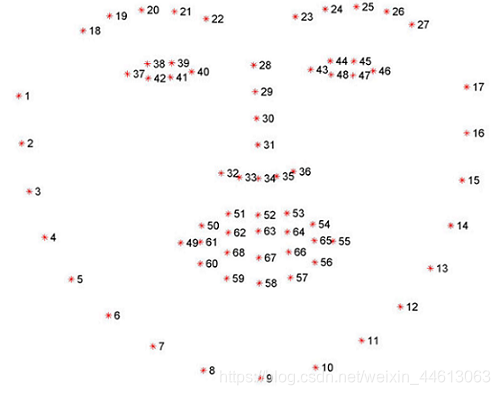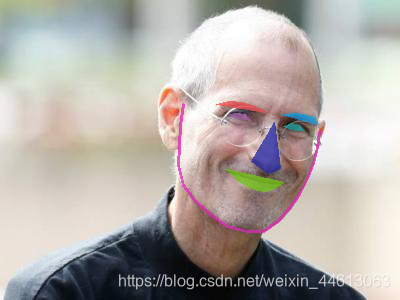imutils 这个图像处理工具包,除了简化 opencv 的一些操作之外,还有专门配合 dlib 处理人脸数据的工具 face_utils。dlib 提取人脸数据后,五官都是用一些特征点来表示的,每个部位的点的索引是固定的,想要进一步操作就得对这些点进行处理,而 face_utils 就是简化这些点的表现方式
本文就来解析一下 face_utils 的处理方法,方便我们理解它的用处
查看源码:
#For dlib’s 68-point facial landmark detector:
FACIAL_LANDMARKS_68_IDXS = OrderedDict([
("mouth", (48, 68)),
("inner_mouth", (60, 68)),
("right_eyebrow", (17, 22)),
("left_eyebrow", (22, 27)),
("right_eye", (36, 42)),
("left_eye", (42, 48)),
("nose", (27, 36)),
("jaw", (0, 17))
])
特征点区域图:
dlib 提取人脸特征点是用 68 个点包围每个部位,如上图,例如第 37 个点到第 42 个点就代表右眼,在图片上这几个点若显示出来就是把右眼那块区域包围着,可以通过这些点之间距离的变化来判断人脸的变化,比如是否眨眼等操作
imutils 通过 OrderedDict 把这些点的索引与其表示的区域直接通过字典形式联系起来,之后再提取某个部位的点时,就不用去查点的索引分布了,例如想提取嘴部特征点,其索引可以通过:
(mStart, mEnd) = face_utils.FACIAL_LANDMARKS_68_IDXS["mouth"]
把 FACIAL_LANDMARKS_68_IDXS 打印出来看看:
查看源码:
def rect_to_bb(rect):
# take a bounding predicted by dlib and convert it
# to the format (x, y, w, h) as we would normally do
# with OpenCV
x = rect.left()
y = rect.top()
w = rect.right() - x
h = rect.bottom() - y
# return a tuple of (x, y, w, h)
return (x, y, w, h)
dlib 提取人脸区域是后是用 4 个数表示,分别代表上下左右的边界。
rect_to_bb 将其转换为坐标信息,即(左上角横坐标, 左上角纵坐标, 矩形宽度, 矩形长度),之后就可以通过这个坐标将人脸区域用矩形框出来显示
查看源码:
def shape_to_np(shape, dtype="int"):
# initialize the list of (x, y)-coordinates
coords = np.zeros((shape.num_parts, 2), dtype=dtype)
# loop over all facial landmarks and convert them
# to a 2-tuple of (x, y)-coordinates
for i in range(0, shape.num_parts):
coords[i] = (shape.part(i).x, shape.part(i).y)
# return the list of (x, y)-coordinates
return coords
dlib 提取人脸的 68 个特征点之后,是用自身的 dlib.full_object_detection 格式保存它们的坐标信息,每次提取坐标都需要用 (shape.part(i).x, shape.part(i).y)形式
shape_to_np 将 68 个特征点的坐标提取出来后,再用 numpy 保存为坐标点矩阵,方便其使用
查看源码:
def visualize_facial_landmarks(image, shape, colors=None, alpha=0.75):
# create two copies of the input image -- one for the
# overlay and one for the final output image
overlay = image.copy()
output = image.copy()
# if the colors list is None, initialize it with a unique
# color for each facial landmark region
if colors is None:
colors = [(19, 199, 109), (79, 76, 240), (230, 159, 23),
(168, 100, 168), (158, 163, 32),
(163, 38, 32), (180, 42, 220)]
# loop over the facial landmark regions individually
for (i, name) in enumerate(FACIAL_LANDMARKS_IDXS.keys()):
# grab the (x, y)-coordinates associated with the
# face landmark
(j, k) = FACIAL_LANDMARKS_IDXS[name]
pts = shape[j:k]
# check if are supposed to draw the jawline
if name == "jaw":
# since the jawline is a non-enclosed facial region,
# just draw lines between the (x, y)-coordinates
for l in range(1, len(pts)):
ptA = tuple(pts[l - 1])
ptB = tuple(pts[l])
cv2.line(overlay, ptA, ptB, colors[i], 2)
# otherwise, compute the convex hull of the facial
# landmark coordinates points and display it
else:
hull = cv2.convexHull(pts)
cv2.drawContours(overlay, [hull], -1, colors[i], -1)
# apply the transparent overlay
cv2.addWeighted(overlay, alpha, output, 1 - alpha, 0, output)
# return the output image
return output
68 个特征点提取出来后,已经将人脸的每个部位标记出来,之后就可以每个部位进行标记,例如将每个部位用不同颜色覆盖。而上面代码中的函数就是进行这个操作
2 个必要参数:
使用后效果图:
里面使用了 opencv 的 convexHull、drawContours 和 addWeighted 方法,看一下它们的参数和作用:cv2.convexHull(points,clockwise,returnpoints)
cv2.drawContours(image,contours,contourIdx,color,thickness=None,lineType=None,hierarchy=None,maxLevel=None,offset=None)
cv2.addWeighted(image1, alpha,image2,beta,gamma[,dst[,dtype]])
经过这 3 个方法后,人脸的每个部位就被标记出来了
免责声明:本文系网络转载或改编,未找到原创作者,版权归原作者所有。如涉及版权,请联系删